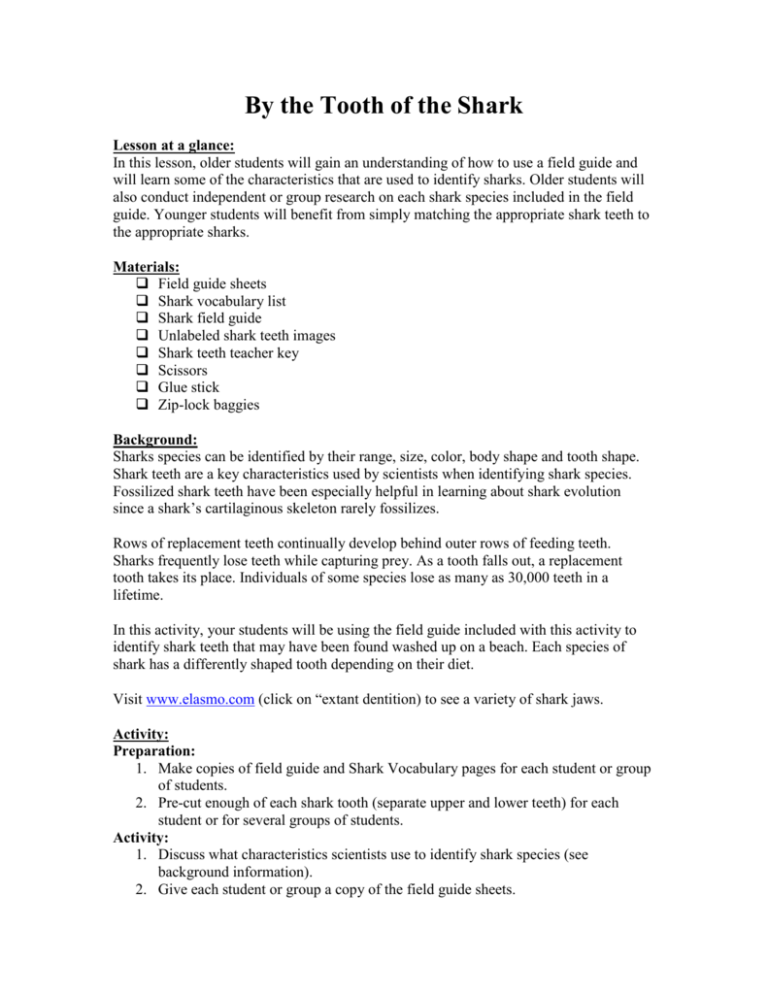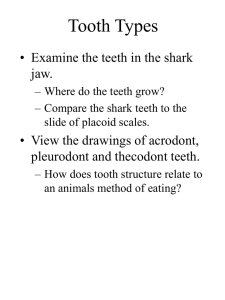Tooth Taxonomy
advertisement

By the Tooth of the Shark Lesson at a glance: In this lesson, older students will gain an understanding of how to use a field guide and will learn some of the characteristics that are used to identify sharks. Older students will also conduct independent or group research on each shark species included in the field guide. Younger students will benefit from simply matching the appropriate shark teeth to the appropriate sharks. Materials: Field guide sheets Shark vocabulary list Shark field guide Unlabeled shark teeth images Shark teeth teacher key Scissors Glue stick Zip-lock baggies Background: Sharks species can be identified by their range, size, color, body shape and tooth shape. Shark teeth are a key characteristics used by scientists when identifying shark species. Fossilized shark teeth have been especially helpful in learning about shark evolution since a shark’s cartilaginous skeleton rarely fossilizes. Rows of replacement teeth continually develop behind outer rows of feeding teeth. Sharks frequently lose teeth while capturing prey. As a tooth falls out, a replacement tooth takes its place. Individuals of some species lose as many as 30,000 teeth in a lifetime. In this activity, your students will be using the field guide included with this activity to identify shark teeth that may have been found washed up on a beach. Each species of shark has a differently shaped tooth depending on their diet. Visit www.elasmo.com (click on “extant dentition) to see a variety of shark jaws. Activity: Preparation: 1. Make copies of field guide and Shark Vocabulary pages for each student or group of students. 2. Pre-cut enough of each shark tooth (separate upper and lower teeth) for each student or for several groups of students. Activity: 1. Discuss what characteristics scientists use to identify shark species (see background information). 2. Give each student or group a copy of the field guide sheets. 3. Discuss scientific vs. common names. Scientific names are used by scientists all over the world regardless of the language they speak. Scientific names are usually Greek or Latin and include the genus group the animal belongs to and its species. Common names may vary worldwide or even within one region. 4. Explain to students that they will be doing research to find the range and diet of each of the sharks included in the field guide. Students should use a variety of resources including books and the internet. 5. Have at least one regular field guide available for students to reference. 6. Once the research portion of the activity is completed, give each student or group a glue stick and a baggie with the pre-cut, unlabeled shark teeth. 7. Have the students match the loose teeth with the shark species on the field guide pages. 8. On a separate piece of paper have students make a shark tooth key by gluing the shark teeth to the paper and labeling them. 9. Encourage students to make a connection between the kinds of food each shark eats and how their teeth might help them to catch and consume their prey. Extensions: 1. Have students choose a different species of shark, skate or ray. Next, have then find their diet, range and a description of the shark including their teeth (if available). 2. Have students create a report on a species of shark that includes a drawing of the shark and its teeth. Shark Field Guide Upper tooth Lower tooth Common name: Tiger Shark Scientific name: Galeocerdo cuvier Description: Tiger sharks have a torpedo shaped body. Their back is gray with dark stripes. Their first dorsal fin is much larger than their second dorsal fin. Length: up to 18 feet Range: Diet: Upper tooth Lower tooth Common name: Sevengill shark Scientific name: Notorynchus maculatus Description: Sevengills have a long, rounded body. They are brownish to dark gray and usually have many dark spots covering their bodies. Unlike most sharks these sharks have seven gill slits on either side of their head rather than five. They are also unique in that they only have one dorsal fin. The teeth in their upper jaw are shaped differently than the teeth in their lower jaw. Length: up to 10 feet Range: Diet: Upper teeth Lower tooth Common name: Cookie-cutter shark Scientific name: Isistius brasiliensis Description: These little sharks are chocolate colored over most of their bodies with a dark collar around their gill slits. They have no anal fin. Their eyes are green. Cookiecutter sharks feed on prey larger than themselves. Their fleshy lips help them to suck onto their prey while they use their teeth to remove a chunk of flesh. Length: up to 1.5 feet Range: Diet: Upper tooth Lower tooth Common name: Soupfin shark Scientific name: Galeorhinus zyopterus Description: Soupfin sharks have very sleek torpedo shaped bodies. They are gray on their backs and lighter colored on their bellies. Their snout is long and pointed. Their second dorsal fin is smaller than their first dorsal fin. Length: up to 8 feet Range: Diet: Upper tooth Lower tooth Common name: White shark Scientific name: Carcharadon carcharias Description: White sharks can be quite robust. They are gray or brownish on their backs and lighter gray to white on their bellies. Their snout is pointed. Their anal fin is located directly under their second dorsal fin. The caudal fin is crescent shaped with each lobe being roughly the same size. Their teeth are triangular and serrated. Length: up to 21 feet Range: Diet: Upper tooth Lower tooth Common name: Shortfin mako Scientific name: Isurus oxyrinchus Description: Their torpedo shaped body is grayish blue to deep blue above, white below. The snout is sharply pointed. The caudal fin is crescent shaped with both lobes equal in size. Mako’s are one of the fastest swimming sharks. They have fewer teeth than most shark species. Their teeth are pointed by not serrated. Often mistaken for a white shark. Length: up to 13 feet Range: Diet: Upper tooth Lower tooth Common name: Leopard shark Scientific name: Triakis semifasciata Description: Leopard sharks are silvery gray or brown with black spots and wide black stripes. Their dorsal fins are approximately the same size. Pectoral fins are pointed. These sharks have tiny spiracles behind their eyes that help them to pump water over their gills as they rest on the seafloor. Length: up to 6.5 feet Range: Diet: Upper tooth Lower tooth Common name: Salmon shark Scientific name: Lamna ditropis Description: Salmon sharks have stout, torpedo shaped bodies. They are a dark bluish gray on their backs and white on the lower sides of their body, including their belly. Their snout is coned shaped and very pointed. Their three pronged teeth have smooth edges. Length: up to 10 feet Range: Diet: Shark Teeth (Teacher’s Key) Cookie-cutter shark Leopard shark Salmon shark Soupfin shark Sevengill shark Shortfin mako Tiger shark White shark Shark Teeth Directions: 1. Make enough copies so that each group or individual student has a set. 2. Pre-cut teeth and place each set in a baggie.







